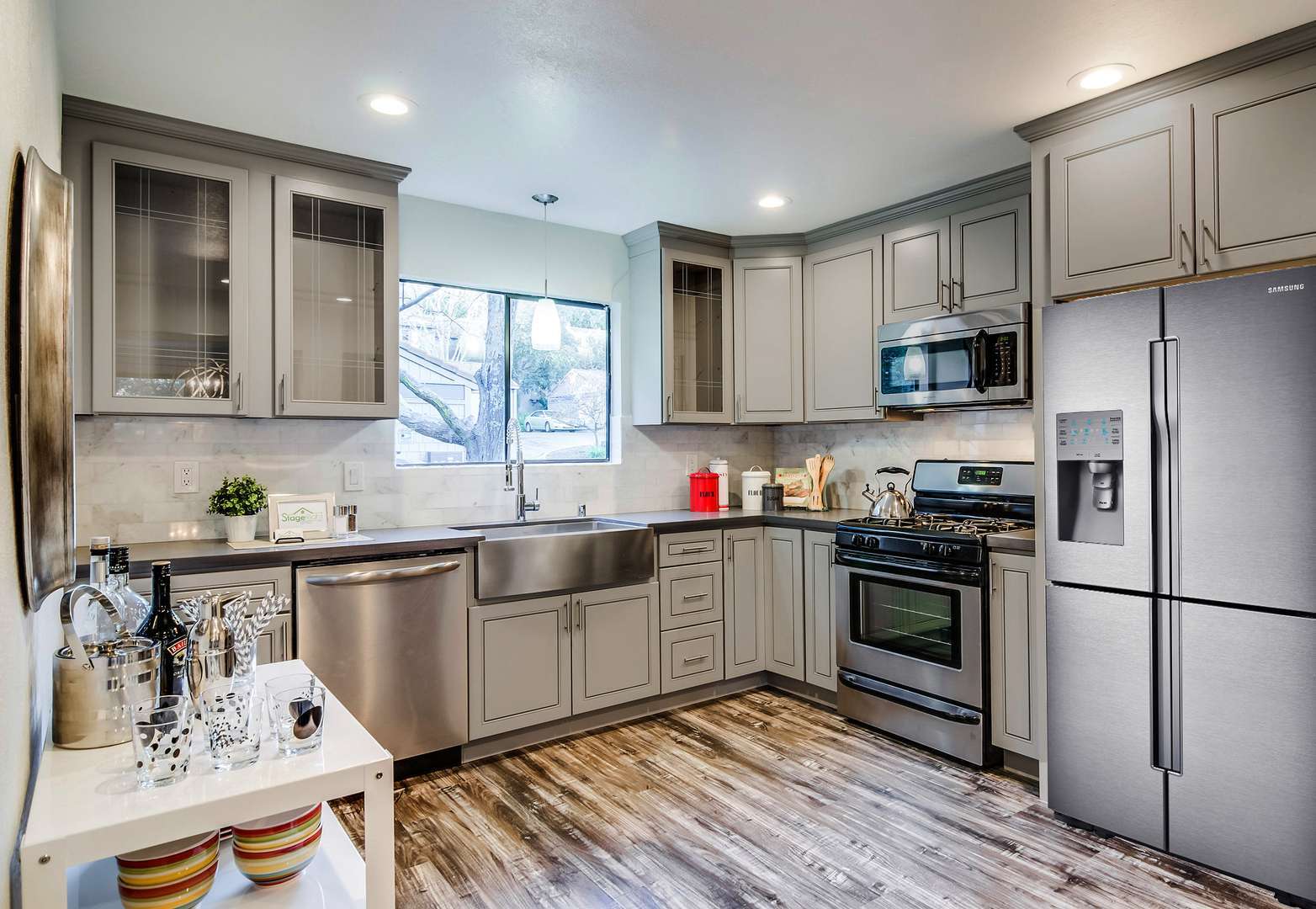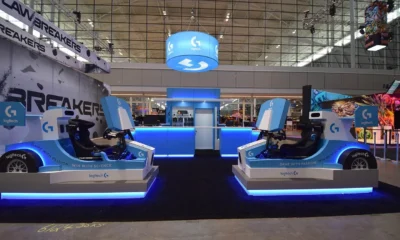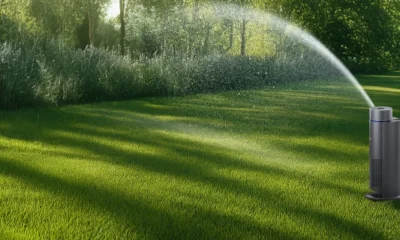Lifestyle
7 Crucial Questions That Guarantee Premium Cabinets Worth Every Penny

Have you ever wondered why some kitchen cabinets look worn out after just a few years while others maintain their beauty and functionality for decades? The secret lies not in what you see on the showroom floor, but in what you ask before making your purchase. Most homeowners don’t realize that asking the right questions can be the difference between cabinets that deteriorate prematurely and those that become family heirlooms.
Most homeowners spend 40% of their kitchen renovation budget on cabinetry, yet many fail to ask the critical questions that separate exceptional craftsmanship from expensive disappointments. This comprehensive guide reveals the exact questions that industry experts use to identify truly premium cabinets worth every penny invested, saving you thousands while ensuring decades of satisfaction.
The Hidden Value of Custom Kitchen Cabinets
Custom cabinetry doesn’t have to mean breaking the bank. When approached with insider knowledge, custom cabinets offer unmatched value through perfect space utilization, materials selected specifically for your environment, and craftsmanship that withstands decades of daily use.
While mass-produced cabinets might seem economical initially, they often waste valuable space due to standardized sizing that rarely fits perfectly in your kitchen. Custom cabinets, by contrast, maximize every inch of available space, often resulting in up to 30% more storage in the same footprint. This efficiency alone can justify the investment for many homeowners.
Today’s savvy homeowners are discovering that asking the right questions before commissioning custom cabinets can save thousands while ensuring superior quality. Let’s explore the seven questions that guarantee exceptional results every time.
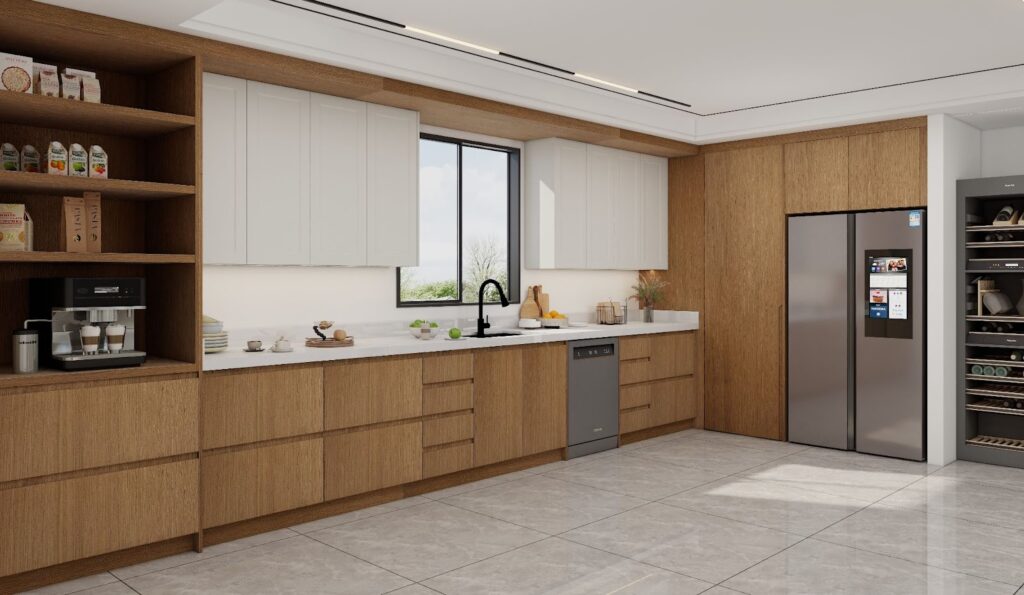
Question #1: What Materials Do You Use for Each Cabinet Component?
The foundation of cabinet quality begins with materials selection. Inferior materials might not be visible initially, but they reveal themselves through premature failure and disappointing performance. This question immediately separates premium craftspeople from those using cost-cutting shortcuts.
What experts look for:
- Box construction: Premium cabinets use plywood rather than particle board, especially critical in humid environments where moisture resistance matters. The difference becomes apparent when a water leak occurs – particle board rapidly swells and disintegrates, while quality plywood maintains structural integrity.
- Drawer boxes: Solid wood with dovetail joints provides decades of smooth operation and can handle the weight of heavy items like cookware without sagging or breaking.
- Face frames: Solid hardwood delivers both strength and lasting beauty, with maple, cherry, and oak being particularly resilient choices for everyday use.
- Joinery methods: Prioritize doweled, dovetailed, or mortise-and-tenon construction over stapled joints, which can loosen over time with normal kitchen vibrations and temperature changes.
Some of the top 10 cabinet manufacturers in Australia have pioneered exceptional material standards, including higher-grade plywood components and moisture-resistant technologies designed specifically for extreme climate variations. These Australian innovations include specially formulated adhesives that maintain bond strength even in tropical conditions and strategic use of expansion joints that allow wood to naturally move with humidity changes without compromising structural integrity. Their innovative approaches to material selection have raised the bar for durability and performance worldwide.
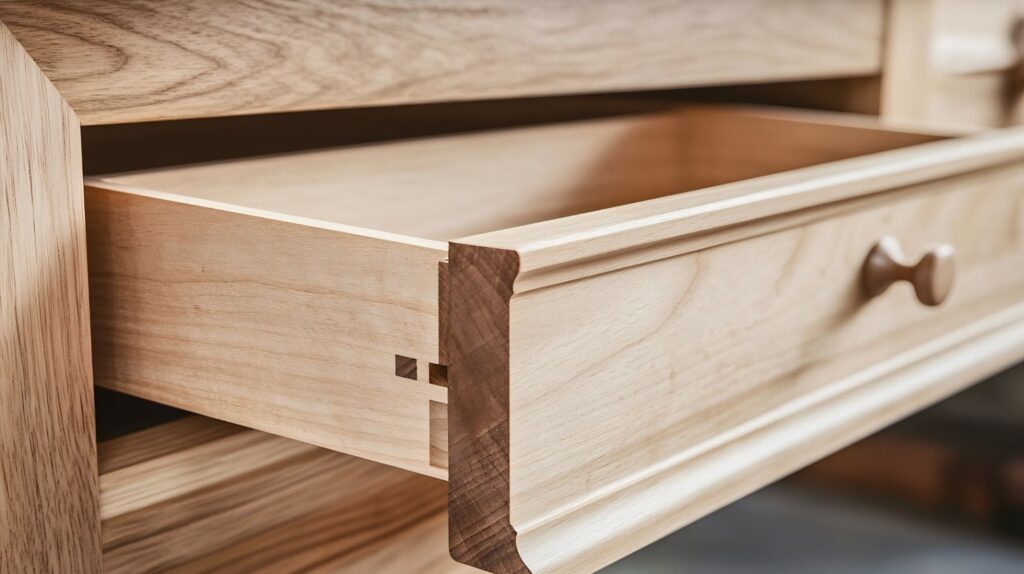
Question #2: What Hardware Components Do You Offer?
Even beautifully constructed cabinets will frustrate users daily if the hardware doesn’t perform flawlessly. This question reveals whether your cabinet maker prioritizes long-term functionality or merely surface aesthetics. Hardware typically accounts for 15-20% of total cabinet cost, but its impact on daily satisfaction is immeasurable.
Quality indicators include:
- Drawer slides: Ball-bearing slides with full extension capacity ensure smooth operation even when drawers are fully loaded. Premium options offer 100,000+ cycle ratings, meaning they’ll operate smoothly for decades of daily use. Look for slides with at least 75-pound weight capacity for standard drawers and 100+ pounds for larger drawers.
- Hinges: Soft-close mechanisms prevent slamming while extending cabinet life by reducing repeated impact stress. European-style concealed hinges with 6-way adjustment capabilities allow for precise door alignment even as your home subtly settles over time.
- Pulls and knobs: Solid metal fixtures resist bending and breaking over time. Avoid hollow or plated hardware that can wear through with frequent use. Stainless steel, solid brass, and bronze options offer both durability and timeless appeal.
- Shelf supports: Metal clips or embedded systems prevent dangerous shelf collapse under weight. Adjustable shelf systems with metal inserts provide flexibility while maintaining strength that plastic alternatives cannot match.
Hardware quality often reveals a cabinet maker’s overall philosophy. Those who invest in premium functional components typically apply the same care to less visible aspects of construction.
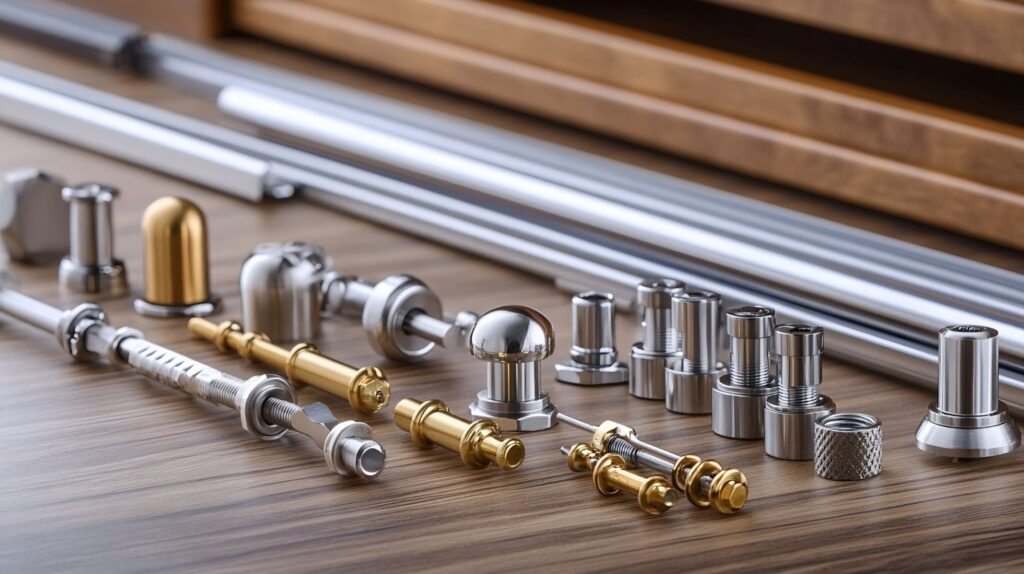
Question #3: What Finish System Do You Use?
The finish not only determines appearance but serves as your cabinets’ primary defense system. Multiple layers properly applied and cured make the difference between lasting beauty and premature deterioration. This question uncovers whether the cabinet maker understands the science of wood protection.
Premium finish characteristics:
- Multiple layers including sealers, base coats, and protective top coats, often totaling 5-7 applications for maximum durability
- Catalyzed finishes that chemically cure to resist heat, moisture, and daily wear, offering significantly stronger molecular bonds than air-dried alternatives
- Even application without drips, bubbles, or inconsistencies, requiring specialized spray equipment and dust-free environments
- UV resistance, particularly important for cabinets in sunny kitchens to prevent yellowing or fading over time
- Hand-sanding between each coat to ensure optimal adhesion and smoothness
- Proper curing time between applications, often 24-48 hours, to allow complete hardening before subsequent coats
The finish application environment is equally important. Temperature and humidity-controlled spray rooms ensure consistent results impossible to achieve in variable conditions. Ask whether your cabinet maker maintains such facilities or outsources finishing to specialists.
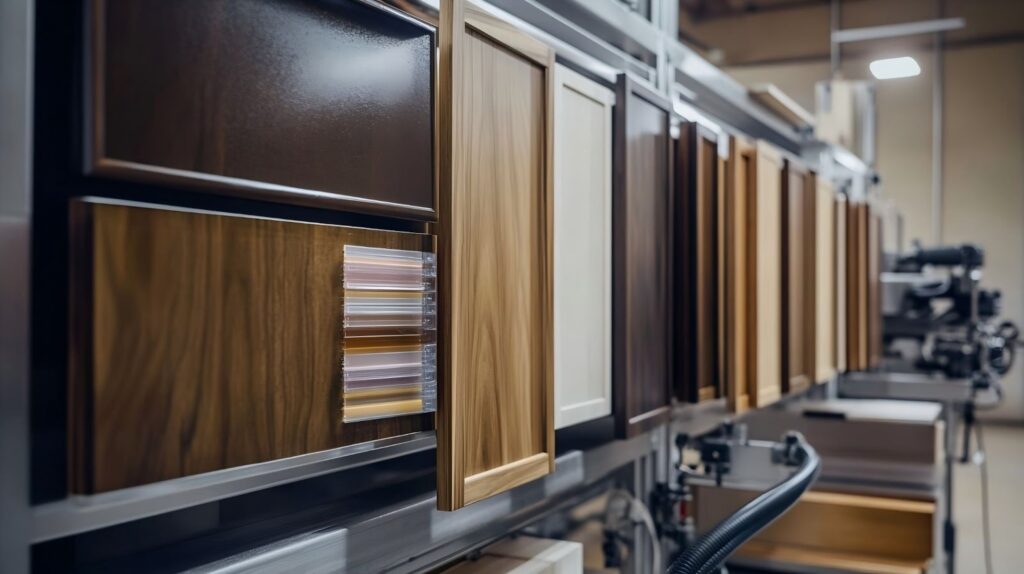
Question #4: What Joinery Methods Do You Employ?
Joinery—how cabinet components connect—determines structural integrity. This question separates skilled craftspeople from those cutting corners. Quality joinery requires specialized equipment, expertise, and time that mass producers rarely invest.
Superior joinery includes:
- Dovetail connections for drawer boxes, creating interlocking joints that strengthen with pressure
- Mortise-and-tenon joints for frames, providing mechanical strength beyond what glue alone can achieve
- Doweled construction for box assembly, creating precise alignment and superior strength compared to stapled alternatives
- Reinforced corner blocking to prevent cabinet racking under weight
- Dado joints to support shelving, distributing weight along the entire edge rather than resting on shelf pins alone
Canadian kitchen cabinet makers are particularly renowned for their joinery excellence, balancing traditional woodworking techniques with modern precision. Their unique approach combines Old World craftsmanship with innovative technology, resulting in joinery that maintains structural integrity despite extreme seasonal temperature and humidity variations. Their access to high-quality northern hardwoods with tight grain patterns enables joinery techniques that would be impossible with less stable materials. This combination of exceptional materials and advanced techniques results in cabinetry that maintains structural integrity for decades while offering the precision and consistency modern homeowners expect.
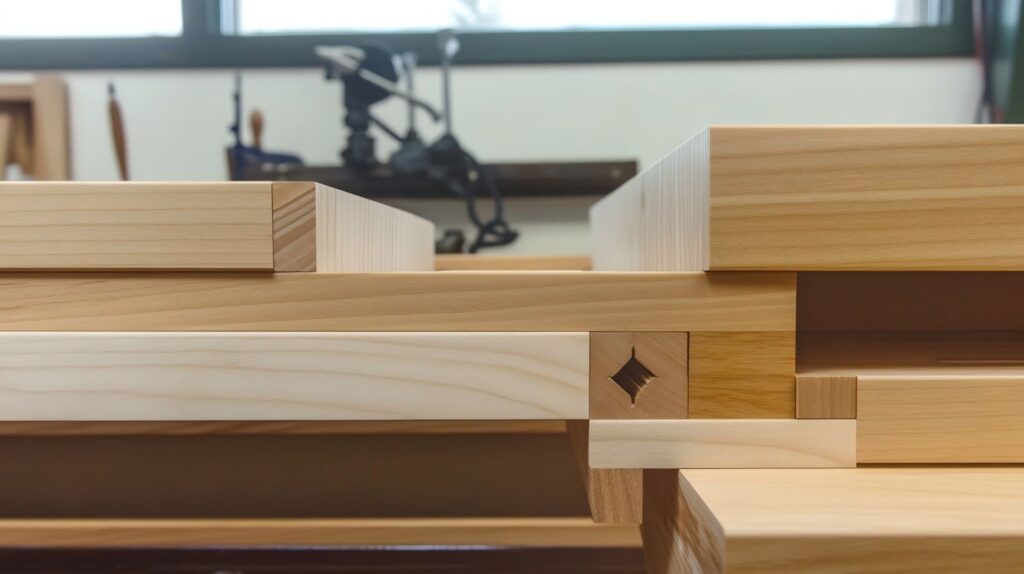
Question #5: What Quality Control Processes Do You Have?
This question reveals whether a cabinet maker has systematic approaches to ensuring consistency or relies on chance. Quality control separates true professionals from amateur operations and provides insight into the consistency you can expect across your entire project.
Look for processes that include:
- Multiple inspection points throughout manufacturing, with documented checklists and verification
- Humidity-controlled workshop environments that prevent wood movement during construction
- Testing protocols for hardware functionality, including cycle testing of hinges and slides
- Moisture content verification to ensure wood has been properly dried to prevent future warping
- Gap and alignment checks using precision tools rather than visual assessment alone
- Final quality verification before delivery, including function testing of all moving parts
- Photographic documentation of completed cabinets before shipping
Ask whether your cabinet maker employs dedicated quality control specialists or relies solely on the craftspeople who built the cabinets. Independent verification often catches issues that might otherwise be overlooked.
Alt:Wooden cabinet doors being tested at a quality control station with measurement tools, hardware testers, and inspection checklist.
Question #6: Can I See Examples and Samples of Your Work?
Nothing reveals workmanship quality like examining finished products. This question ensures you’re not relying solely on promises or gallery photos that showcase only the best examples. The willingness to share real examples often correlates directly with confidence in workmanship.
Request to:
- Visit completed projects to examine craftsmanship firsthand, especially kitchens that have been in use for several years
- Receive sample doors in your desired style and finish to evaluate in your own lighting conditions
- Inspect edge treatments, joint quality, and finish consistency, paying special attention to complex details
- Test drawer slides and door hinges for smooth operation without binding or excessive play
- Check for tight seams and consistent gaps around doors and drawers, which indicate precise manufacturing
- Examine interior surfaces, which often reveal more about quality standards than visible exteriors
- Speak with previous clients about their experience, particularly regarding how the cabinets have performed over time
Remember that even minor inconsistencies in new cabinets tend to become more noticeable over time. What might seem like insignificant variation initially can become a daily irritation years later.
Alt:Contemporary kitchen with dark wood cabinets, white countertops, central island, and pendant lighting.
Question #7: What Warranties Stand Behind Your Work?
Premium cabinet makers confidently stand behind their craftsmanship with comprehensive warranties. This question immediately separates those who truly believe in their product from those hoping you won’t notice problems. Warranty terms often reveal more about expected longevity than any marketing claims.
Quality assurance indicators:
- Minimum 5-year warranties, with 10+ years on premium craftsmanship and lifetime warranties on structural elements
- Detailed documentation of construction standards included with warranty information
- Certification paperwork where applicable, including compliance with industry standards
- Compliance verification with environmental and safety standards such as CARB for formaldehyde emissions or Greenguard for indoor air quality
- Clear explanation of what is covered and excluded, avoiding vague language that provides loopholes
- Transferable warranty terms that add value when selling your home
- Established process for addressing issues with appropriate response timeframes
A cabinet maker’s willingness to guarantee their work for extended periods demonstrates confidence in their materials, construction methods, and finishing techniques. Those offering minimal warranties may expect problems within that timeframe.
Maximizing Value: The True Cost Equation
Understanding real value factors helps you make informed decisions beyond initial price. The wisest investment isn’t necessarily the lowest upfront cost but rather the cabinets that deliver decades of trouble-free performance and daily satisfaction.
The value equation includes:
- Material quality (30-40% of cabinet cost) determines longevity and performance
- Skilled craftsmanship (another 30-40%, depending on complexity) ensures structural integrity and precision
- Design expertise that ensures optimal functionality and ergonomics for your specific needs
- Perfect fit that eliminates wasted space, often providing 20-30% more storage than prefabricated alternatives
- Reduced replacement costs over time, as quality cabinets typically last 30+ years compared to 10-15 for standard options
- Energy investment in production and materials, making longer-lasting options more environmentally responsible
Remember that renovating your kitchen creates significant disruption. Investing in cabinets that won’t need replacement for decades saves both money and future inconvenience.
Alt:Open-concept living and dining area with custom kitchen cabinets, wood furniture, and pendant lighting in a cozy, neutral-toned interior.
Working With Your Custom Cabinet Maker
Once you’ve selected a craftsperson using the seven crucial questions, build a strong working relationship through clear communication and reasonable expectations. This partnership approach yields the best results in both product quality and overall experience.
Effective communication practices:
- Establish clear specifications with detailed drawings and written documentation
- Request regular progress updates with photos during key manufacturing stages
- Visit the workshop if possible during production to see your cabinets taking shape
- Address any concerns early when adjustments are easier and less costly to implement
- Create a detailed installation schedule that coordinates with other contractors
- Conduct a thorough walk-through upon completion before final payment
- Maintain contact information for future questions or maintenance needs
Timeline considerations:
- Quality custom cabinets typically require 8-12 weeks from final design approval to installation
- Add buffer time to your renovation schedule for unexpected challenges
- Understand that properly dried wood and correctly cured finishes cannot be rushed
- Schedule installation during lower humidity periods if possible for optimal results
- Allow time for proper acclimation of cabinets to your home environment before installation
Your Path to Cabinet Perfection
By arming yourself with these seven crucial questions, you gain the power to identify truly premium cabinets worth every penny. Remember that the real value of kitchen cabinetry isn’t measured by initial price alone but by years of trouble-free use and daily satisfaction.
Well-constructed custom cabinets might require a greater initial investment, but they deliver significantly greater lifetime value through extended lifespan, superior functionality, and perfect fit for your space. Your kitchen deserves nothing less than cabinetry that will serve your family beautifully for decades to come.
FAQs
What’s the typical timeline for custom cabinet projects? Most quality custom cabinet makers require 8-12 weeks from final design approval to installation, though complex projects may take longer. This timeline includes design finalization, material ordering, construction, finishing, and installation coordination.
How do custom cabinets compare in cost to high-end prefabricated options? Custom cabinets typically cost 20-30% more than premium prefabricated options initially but provide greater lifetime value through perfect space utilization, personalized features, and exceptional quality control. The price difference often equalizes when considering the extended lifespan of custom cabinetry.
Can custom cabinet makers match specific design styles? Yes, skilled custom cabinet makers can create virtually any style, from traditional to ultra-modern, with precise details matched to your specifications. Their ability to create transitional designs that bridge multiple styles offers particular value in creating timeless kitchens that won’t feel dated as trends change.
What’s the process for designing custom cabinets? The process typically involves initial consultation, space measurement, preliminary design, material selection, detailed drawings, final approval, fabrication, and installation. Each stage provides opportunities for refinement and personalization impossible with mass-produced alternatives.
Lifestyle
Ride in Style: Why Every Couple Deserves a Wedding Limo Toronto

Your wedding day is one of the most memorable days of your life and every moment deserves a touch of elegance. From the venue and décor to the first dance, everything is planned to perfection. But there’s one thing that can make your special day feel truly magical: arriving in a Toronto Wedding Limo.
When you think of a limousine, you imagine luxury, comfort, and style the exact things every bride and groom deserve. Whether you’re planning a grand celebration in downtown Toronto or an intimate ceremony on the city’s outskirts, a wedding limo adds class, convenience, and a stress-free travel experience.
The Magic of a Toronto Wedding Limo Experience.
A Wedding Limo Toronto isn’t just transportation it’s a statement. It’s the grand entrance that tells your guests, “This is our moment.” The chauffeur opens the door, the camera flashes, and for a second, you feel like royalty.
Toronto’s skyline provides the perfect backdrop for timeless wedding photos. Imagine you and your partner stepping out of a sleek stretch limo in front of the CN Tower or the Distillery District. The scene alone adds a cinematic flair to your day something that stays in memory (and on Instagram) forever.
Stress Free Travel for Your Big Day.
Let’s be real: weddings can get hectic. There’s always a last minute flower mix-up, a missing boutonniere, or traffic that tests your patience. The last thing you should worry about is getting from point A to point B on time.
A Toronto Wedding Limo takes all that stress away. Professional chauffeurs are experts in city navigation. They arrive early, plan the route, and ensure every stop (home, photoshoot location, venue, reception) runs smoothly. It’s not just about luxury it’s about peace of mind.
Comfort, Space, and Glamour Combined.
Wedding dresses aren’t exactly made for small cars. A limo provides the space to move comfortably, fix your dress, or take a moment to breathe before walking down the aisle. Plus, with plush leather seats, soft lighting, chilled champagne, and your favorite playlist, it’s a private retreat before the ceremony begins.
Many couples even choose to use their Toronto Wedding Limo as a mini celebration space after the ceremony. Pop open a bottle of bubbly, enjoy a quiet moment together, and soak in the reality that you’re married!
Impress Your Guests in Style.
Guests notice everything especially your arrival. Pulling up in a stunning limousine instantly sets the tone for the day. It tells your guests that this isn’t just another event it’s a celebration of love, class, and unforgettable experiences.
And if you really want to take it up a notch, consider booking a fleet of limos for your bridal party or family. Coordinated arrivals make logistics easy and look absolutely amazing in photos and videos.
Affordable Luxury for Every Couple.
One common misconception is that limousines are only for the ultra rich. The truth is, Toronto Wedding Limo services come in a variety of packages to suit every budget. You can book an hourly service or choose full day packages that cover transportation from morning prep to the reception exit.
Most companies even offer discounts for weekday weddings or off-season bookings. You get to enjoy luxury without overspending now that’s smart wedding planning.
Capture Every Moment Perfectly.
If you’re investing in a professional photographer, you’ll want the perfect backdrop. Limousines naturally enhance wedding photos. From the bride stepping out of the limo to the couple waving goodbye under the city lights, every shot looks cinematic and polished.
Many couples also use their Toronto Wedding Limo for a post wedding photoshoot, especially at iconic Toronto spots like High Park, the Royal Ontario Museum, or Harbourfront.
Choose the Right Limo for Your Dream Day.
There are many options when booking a Toronto Wedding Limo, depending on your style:
- Stretch Limo: The timeless choice for elegance and space.
- SUV Limo: Perfect for larger bridal parties and a modern vibe.
- Classic Rolls Royce or Bentley: For a vintage, romantic feel.
- Luxury Party Bus: If you want to keep the celebration going between stops!
Ask your limo provider for vehicle photos and interior details before confirming. That way, you know exactly what to expect on your wedding day.
A Few Tips Before Booking.
- Book Early: Toronto’s wedding season gets busy fast. Reserve your limo at least 2–3 months ahead.
- Confirm Details in Writing: Double check pickup times, routes, and extras (champagne, decorations, etc.).
- Inspect the Vehicle: Visit the company or ask for a video tour to make sure the limo matches your vision.
- Ask for Red Carpet Service: It’s the little touches that make a big difference.
Final Thoughts.
A wedding isn’t just an event it’s a once in a lifetime story. And what better way to start that story than in the comfort, style, and sophistication of a Toronto Wedding Limo From the moment the doors open to your grand exit, you’ll feel like stars in your own love movie.
So, when you plan your big day, remember you deserve more than just a ride. You deserve a royal experience that reflects your love and personality.
Lifestyle
Mastering Mindfulness: Techniques for Inner Peace

Mindfulness is a mental practice that emphasizes being present in the moment, fully engaging with one’s thoughts, feelings, and surroundings without judgment. Rooted in ancient Buddhist traditions, mindfulness has gained significant traction in contemporary psychology and wellness practices. At its core, mindfulness involves cultivating an awareness of the present, allowing individuals to observe their thoughts and emotions as they arise, rather than becoming entangled in them.
This practice encourages a non-reactive stance toward experiences, fostering a sense of calm and clarity amidst the chaos of daily life. The mechanisms behind mindfulness are both psychological and physiological. When individuals practice mindfulness, they often experience changes in brain activity, particularly in areas associated with emotional regulation and self-awareness.
Research has shown that regular mindfulness practice can lead to increased gray matter density in the hippocampus, which is crucial for memory and learning, as well as in the prefrontal cortex, which governs executive functions such as decision-making and impulse control. Furthermore, mindfulness can reduce the activity of the amygdala, the brain’s fear center, leading to decreased anxiety and stress responses. This intricate interplay between mind and body underscores the profound impact that mindfulness can have on overall well-being.
Breathing Techniques for Mindfulness and Inner Peace
Breathing techniques serve as foundational tools in the practice of mindfulness, providing a direct pathway to achieving inner peace. One of the simplest yet most effective methods is diaphragmatic breathing, also known as abdominal or deep breathing. This technique involves inhaling deeply through the nose, allowing the diaphragm to expand fully, and then exhaling slowly through the mouth.
By focusing on the breath, individuals can anchor themselves in the present moment, creating a sense of calm that permeates both mind and body. This practice not only helps to reduce stress but also enhances oxygen flow to the brain, promoting clarity and focus. Another powerful breathing technique is the 4-7-8 method, which is particularly effective for managing anxiety and promoting relaxation.
In this technique, one inhales quietly through the nose for a count of four, holds the breath for a count of seven, and then exhales completely through the mouth for a count of eight. This rhythmic pattern not only calms the nervous system but also encourages a mindful awareness of one’s breath. Practicing this technique regularly can help individuals develop a greater sense of control over their emotional responses, making it easier to navigate stressful situations with grace and composure.
Mindful Meditation: How to Practice and Incorporate into Daily Life
Mindful meditation is a structured practice that allows individuals to cultivate awareness and presence through focused attention. To begin a mindful meditation session, one can find a quiet space free from distractions. Sitting comfortably with an upright posture is essential; this position promotes alertness while allowing relaxation.
The practice typically starts with focusing on the breath—observing each inhalation and exhalation without trying to change it. As thoughts inevitably arise, practitioners are encouraged to acknowledge them without judgment and gently redirect their focus back to the breath. This process of returning to the breath fosters a sense of patience and acceptance.
Incorporating mindful meditation into daily life can be achieved through various approaches. One effective method is to set aside a specific time each day for practice, even if it’s just five or ten minutes. Morning sessions can set a positive tone for the day ahead, while evening practices can help unwind and reflect on daily experiences.
Additionally, applied mindfulness in Wollongong or at your home can be woven into routine activities such as walking or even washing dishes by maintaining awareness of sensations, sounds, and movements during these tasks. This integration transforms mundane moments into opportunities for mindfulness, enriching everyday life with greater awareness and appreciation.
Cultivating Gratitude and Compassion for a Peaceful Mind
Gratitude and compassion are integral components of mindfulness that significantly contribute to mental well-being. Cultivating gratitude involves recognizing and appreciating the positive aspects of life, no matter how small they may seem. One effective practice is to maintain a gratitude journal where individuals write down three things they are thankful for each day.
This simple act shifts focus from what is lacking to what is abundant in one’s life, fostering a more optimistic outlook. Research has shown that regularly practicing gratitude can lead to improved emotional health, increased resilience, and even better physical health outcomes. Compassion, both toward oneself and others, plays a crucial role in achieving inner peace.
Self-compassion involves treating oneself with kindness during times of struggle or failure rather than engaging in self-criticism. This practice encourages individuals to recognize their shared humanity—understanding that everyone experiences difficulties—and fosters a sense of connection rather than isolation. Engaging in loving-kindness meditation is one way to cultivate compassion; this involves silently repeating phrases wishing well-being for oneself and others.
By nurturing compassion within oneself, individuals can create a more peaceful internal environment that radiates outwardly into their interactions with others.
Mindful Eating: Techniques for Enjoying and Appreciating Food
Mindful eating is an approach that encourages individuals to engage fully with their food experience, promoting healthier eating habits and deeper appreciation for nourishment. This practice begins with creating an environment conducive to eating—free from distractions such as television or smartphones. By sitting down at a table and taking a moment to appreciate the meal before them, individuals can enhance their sensory experience.
Observing colors, textures, and aromas allows for a richer engagement with food that often goes unnoticed in hurried eating scenarios. During meals, it is beneficial to slow down and savor each bite. Chewing thoroughly and paying attention to flavors can transform eating from a mechanical act into a pleasurable experience.
Practicing gratitude before meals—acknowledging the effort that went into preparing the food—can also enhance this experience. Additionally, tuning into hunger cues helps individuals recognize when they are truly hungry versus eating out of boredom or stress. By fostering this awareness around food choices and consumption patterns, mindful eating can lead to healthier relationships with food and improved overall well-being.
Mindful Movement: Incorporating Yoga and Tai Chi for Inner Peace
Mindful movement practices such as yoga and Tai Chi offer unique pathways to cultivate inner peace through physical activity, and can be seen up close during the many Bali cultural tours. Yoga combines breath control with postures that promote flexibility, strength, and balance while encouraging mindfulness throughout the practice. Each pose invites practitioners to connect with their bodies and breath, fostering an awareness of physical sensations and mental states.
This connection not only enhances physical health but also cultivates emotional resilience by encouraging practitioners to remain present amidst discomfort or challenge. Tai Chi, often described as “meditation in motion,” emphasizes slow, deliberate movements that promote relaxation and focus. Originating from martial arts traditions, Tai Chi incorporates principles of balance and harmony while encouraging deep breathing and mental clarity.
Practicing Tai Chi can be particularly beneficial for reducing stress levels; studies have shown that regular participation can lead to lower anxiety levels and improved mood states. Both yoga and Tai Chi provide opportunities for individuals to engage mindfully with their bodies while fostering a sense of tranquility that extends beyond the practice itself.
Managing Stress and Anxiety through Mindfulness Techniques
Mindfulness techniques have proven effective in managing stress and anxiety by promoting awareness of thoughts and feelings without becoming overwhelmed by them. One common approach is body scan meditation, where individuals systematically focus on different parts of their body while observing sensations without judgment. This practice helps cultivate a deeper connection between mind and body while promoting relaxation by releasing tension held in various areas.
Another effective technique is mindful journaling, which allows individuals to express their thoughts and feelings on paper without censorship. By articulating worries or stressors, individuals can gain clarity on their emotions while creating distance from them. This process not only aids in emotional regulation but also fosters problem-solving skills by encouraging reflection on potential solutions or coping strategies.
Integrating these mindfulness techniques into daily routines can empower individuals to navigate stressors with greater ease while enhancing overall emotional resilience.
Creating a Mindful Environment: Tips for Cultivating Inner Peace at Home and Work
Creating a mindful environment is essential for fostering inner peace both at home and in the workplace. One effective strategy is decluttering spaces to promote calmness; clutter can often lead to feelings of overwhelm or distraction. By organizing physical spaces—removing unnecessary items or creating designated areas for specific activities—individuals can cultivate an atmosphere conducive to mindfulness practices.
Incorporating elements of nature into living or working spaces can also enhance mindfulness experiences. Plants not only improve air quality but also create a soothing ambiance that encourages relaxation. Additionally, incorporating soft lighting or calming colors can further promote tranquility within environments.
Establishing designated areas for mindfulness practices—such as meditation corners or quiet reading nooks—can serve as reminders to engage in these practices regularly. By intentionally designing environments that support mindfulness, individuals can create sanctuaries that nurture inner peace amidst the demands of daily life. Whether through simple changes like adding plants or creating quiet spaces for reflection, these adjustments can significantly enhance one’s ability to remain present and centered throughout various activities.
Lifestyle
The True Cost of Lawn Care: Budgeting for a Beautiful Yard
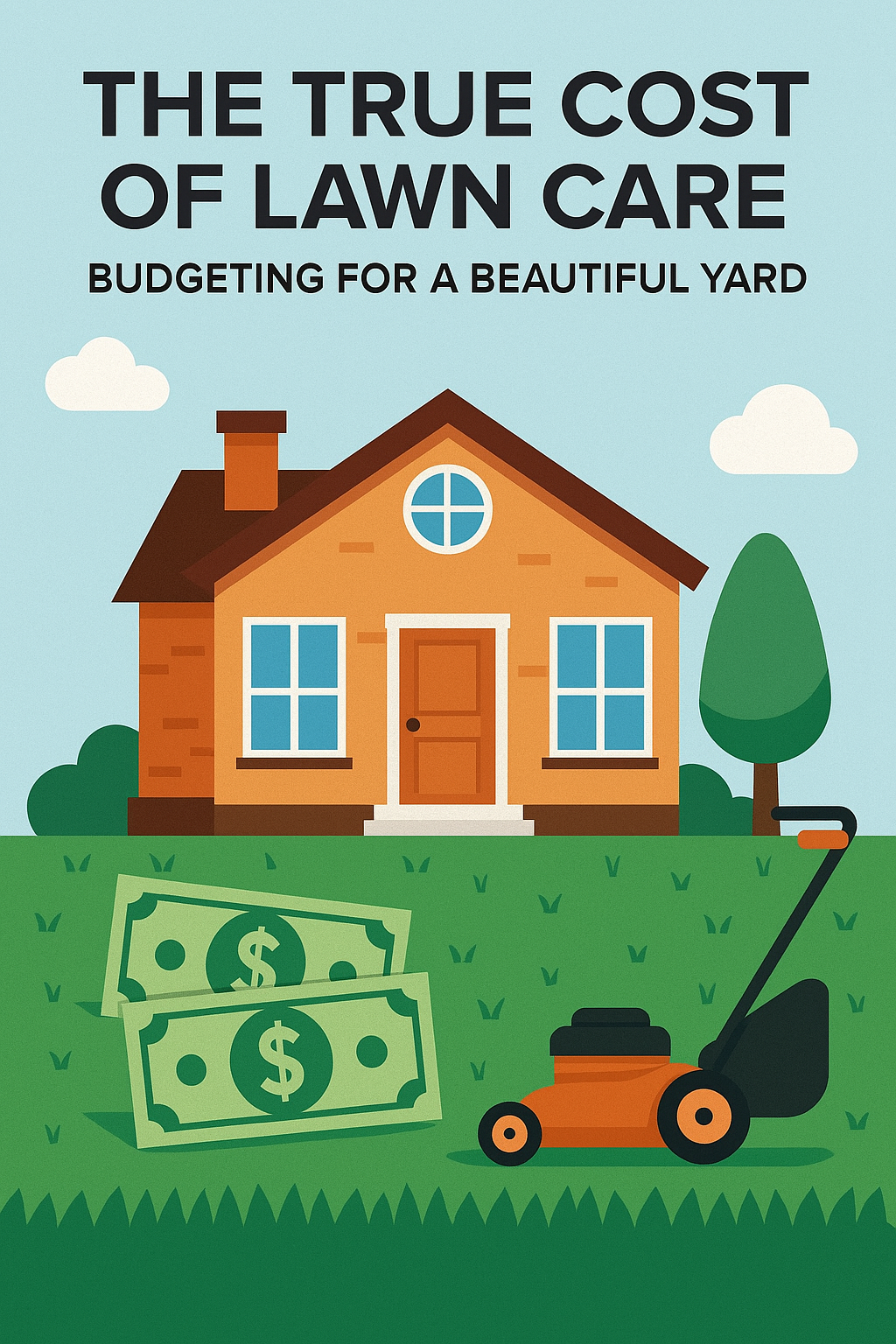
When embarking on a lawn care project, the initial costs can often be a significant factor in determining the overall feasibility of maintaining a healthy and vibrant outdoor space. The first step in understanding these costs involves assessing the size of the area to be maintained. Larger lawns typically require more resources, including seed, fertilizer, and water, which can quickly add up.
For instance, a standard bag of grass seed may cover approximately 1,000 square feet and cost around $30 to $50, while a larger lawn could necessitate multiple bags, leading to an initial investment that can reach several hundred dollars. In addition to seed, other essential components contribute to the initial costs. Soil preparation is crucial for establishing a healthy lawn, which may involve purchasing topsoil or compost to improve soil quality.
Depending on the condition of the existing soil, this could range from $50 to $200 or more. Furthermore, if the lawn requires sod instead of seed for immediate results, the costs can escalate dramatically. Sod prices can vary widely based on the type of grass and local availability, often ranging from $0.30 to $0.80 per square foot.
For a 1,500 square foot lawn, this could mean an expenditure of $450 to $1,200 just for sod alone.
Budgeting for Routine Maintenance
Once the initial setup is complete, routine maintenance becomes a critical aspect of lawn care budgeting. Regular mowing is one of the most visible and necessary tasks, and it can be performed either by hiring a professional service or investing in a quality mower. The cost of hiring a lawn care service can vary significantly based on location and lawn size, typically ranging from $30 to $80 per visit.
If you opt for a self-service approach, purchasing a reliable mower can cost anywhere from $200 to over $1,000, depending on the features and brand. In addition to mowing, other routine maintenance tasks include fertilization, weed control, and pest management. Fertilizers are essential for promoting healthy growth and can cost between $20 and $100 per application, depending on the type and size of your lawn.
Similarly, weed control products can range from $15 to $50 per treatment. It’s important to factor in these recurring expenses when creating a comprehensive budget for lawn care. Over time, these costs can accumulate significantly, making it essential to plan ahead and allocate funds accordingly.
Hidden Costs to Consider
While many costs associated with lawn care are straightforward, several hidden expenses can catch homeowners off guard. One such cost is water usage. Once you buy lawn in Sydney, the costs of maintaining a lush lawn often requires substantial irrigation, especially in drier climates or during summer months.
Depending on local water rates and the size of your lawn, monthly water bills can increase significantly during peak growing seasons. Homeowners should consider investing in a rain gauge or smart irrigation system to monitor water usage effectively and avoid unexpected spikes in utility bills. Another hidden cost is the potential need for soil testing and amendments.
Many homeowners may not realize that their soil may lack essential nutrients or have pH imbalances that can hinder grass growth. Soil testing kits typically range from $10 to $50, but if professional testing is required, costs can rise to $100 or more. Based on the results, additional amendments such as lime or sulfur may be necessary to correct deficiencies, adding further expenses to the overall budget.
These hidden costs underscore the importance of thorough planning and research before diving into lawn care.
Investing in Quality Tools and Equipment
Investing in quality tools and equipment is a crucial aspect of effective lawn care that can yield long-term benefits. While it may be tempting to opt for cheaper alternatives initially, high-quality tools often provide better performance and durability over time. For instance, a well-constructed lawn mower may have a higher upfront cost but can last for years with proper maintenance, ultimately saving money in replacement costs.
Brands known for their reliability often come with warranties that provide peace of mind against defects or failures. In addition to mowers, other essential tools include trimmers, blowers, and aerators. A quality string trimmer can range from $100 to $400, while leaf blowers may cost between $50 and $300.
Aeration tools are also vital for promoting healthy root growth by alleviating soil compaction; renting an aerator can cost around $50 to $100 per day. By investing in these tools rather than opting for lower-quality versions that may break down frequently or require replacement parts, homeowners can ensure their lawn care efforts are efficient and effective.
DIY vs Professional Services: Weighing the Costs
When it comes to lawn care, homeowners often face the decision of whether to tackle maintenance tasks themselves or hire professional services. Each option has its own set of costs and benefits that must be carefully weighed. DIY lawn care can be more economical in the short term; however, it requires time, effort, and a certain level of expertise.
For example, while purchasing fertilizers and equipment may seem less expensive than hiring a service, the time spent researching proper application techniques and performing the work must also be considered. On the other hand, professional lawn care services offer convenience and expertise that many homeowners may lack. These services typically come with a higher price tag but can save time and ensure that tasks are performed correctly.
For instance, a professional service may charge between $40 and $100 per visit for mowing and maintenance but will often include additional services such as fertilization and pest control as part of their package. Homeowners should evaluate their own skills and availability against the costs of professional services to determine which option aligns best with their budget and lifestyle.
Sustainable and Eco-Friendly Options
As environmental concerns continue to grow, many homeowners are seeking sustainable and eco-friendly options for lawn care that align with their values while also being cost-effective in the long run. Organic fertilizers and natural pest control methods are becoming increasingly popular as they reduce chemical runoff into local waterways and promote healthier ecosystems. While organic products may have a higher upfront cost—organic fertilizers can range from $30 to $70 per bag—they often improve soil health over time and reduce the need for synthetic chemicals.
Additionally, implementing xeriscaping techniques can significantly reduce water usage and maintenance costs associated with traditional lawns. This landscaping approach focuses on using drought-resistant plants and minimizing turf areas, which not only conserves water but also reduces mowing frequency and associated fuel costs. Homeowners who choose to transition to xeriscaping may initially invest in new plants and landscaping materials; however, the long-term savings on water bills and maintenance make it an attractive option for those looking to create an environmentally friendly outdoor space.
Long-Term Planning and Budgeting
Effective long-term planning is essential for managing lawn care expenses over time. Homeowners trying to create a beautiful lawn like at Bassendean Oval should consider creating a multi-year budget that accounts for both routine maintenance costs and potential one-time expenses such as equipment purchases or major landscaping projects. By spreading out these costs over several years, homeowners can avoid financial strain while ensuring their lawns remain healthy and well-maintained.
Additionally, setting aside a contingency fund for unexpected expenses is wise. Lawn care can sometimes present unforeseen challenges such as pest infestations or severe weather events that necessitate immediate attention or repairs. By allocating a portion of the budget specifically for these emergencies—typically around 10% of the total budget—homeowners can navigate these situations without derailing their overall financial plan.
Maximizing the Value of Your Lawn Care Budget
To maximize the value of your lawn care budget, it’s essential to prioritize tasks based on their impact on overall lawn health while being mindful of costs. For instance, focusing on proper watering techniques—such as deep watering less frequently—can promote deeper root growth while conserving water resources. This approach not only enhances the health of your lawn but also reduces water bills over time.
Moreover, taking advantage of seasonal sales on fertilizers and equipment can lead to significant savings. Many garden centers offer discounts during off-peak seasons or clearance sales at the end of summer when demand decreases. By planning purchases around these sales cycles, homeowners can acquire high-quality products at reduced prices without compromising on quality.
In conclusion, understanding the various aspects of lawn care budgeting—from initial costs to long-term planning—enables homeowners to make informed decisions that align with their financial goals while maintaining beautiful outdoor spaces. By considering all factors involved in lawn care expenses and prioritizing sustainable practices where possible, individuals can cultivate not only lush lawns but also responsible stewardship of their resources.
-

 Technology3 years ago
Technology3 years agoIs Camegle Legit Or A Scam?
-

 Travel3 years ago
Travel3 years agoNEW ZEALAND VISA FOR ISRAELI AND NORWEGIAN CITIZENS
-

 Technology3 years ago
Technology3 years agoRNDcoin: Korea’s first blockchain project and a world-class cryptocurrency
-

 Uncategorized3 years ago
Uncategorized3 years agoAMERICAN VISA FOR NORWEGIAN AND JAPANESE CITIZENS
-
Lifestyle1 year ago
A Guide to Silverdaddies: What You Need to Know
-

 Fashion1 year ago
Fashion1 year agoGoda Perfume Reviews: Is It Worth Your Investment?
-
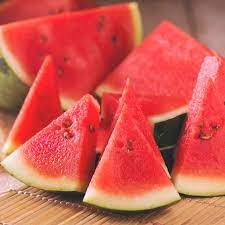
 Health3 years ago
Health3 years agoHealth Benefits Of Watermelon
-

 Home Improvement9 months ago
Home Improvement9 months agoArtificial Grass Designs: Perfect Solutions for Urban Backyards

